
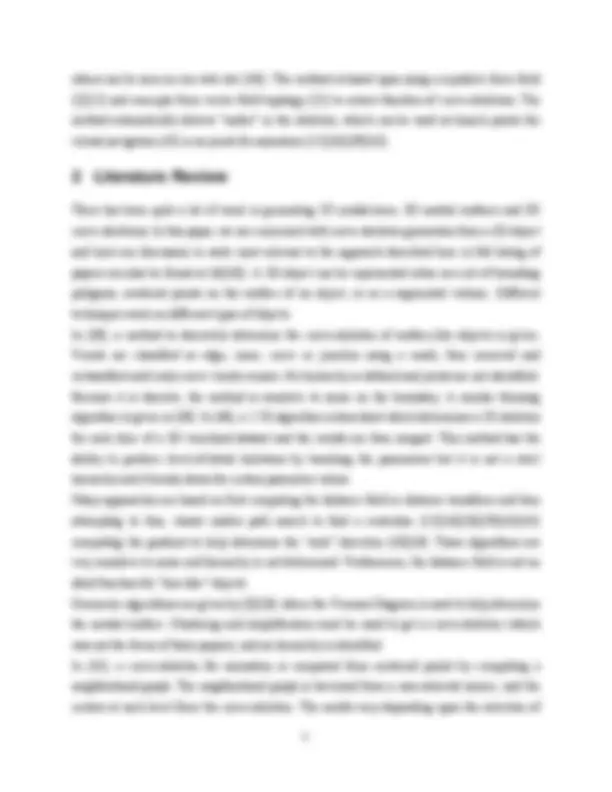
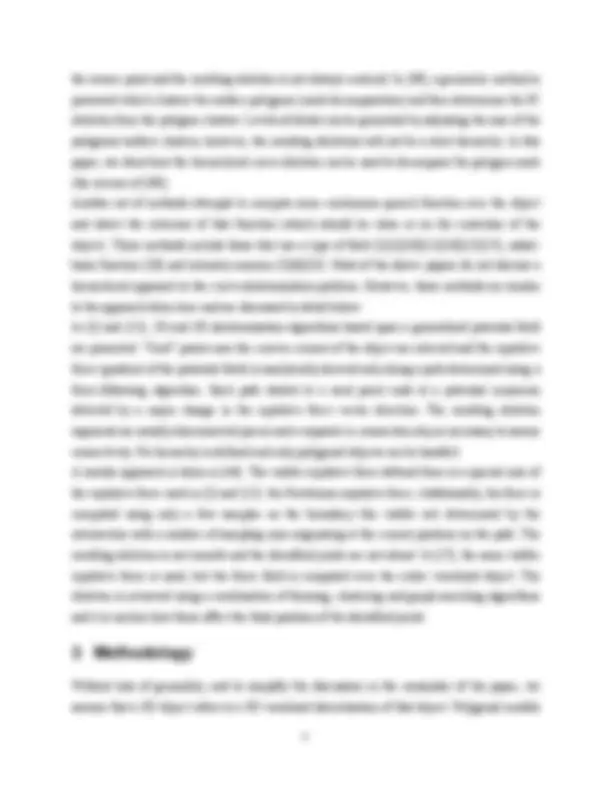
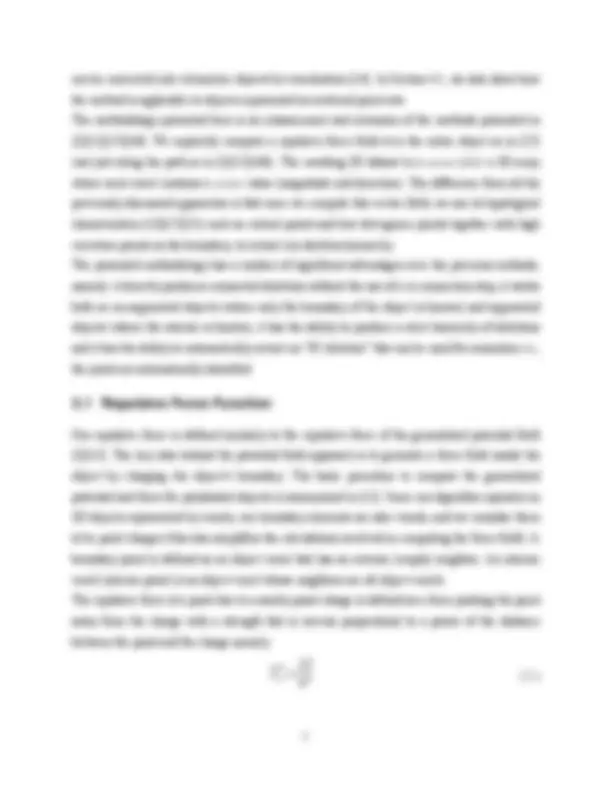
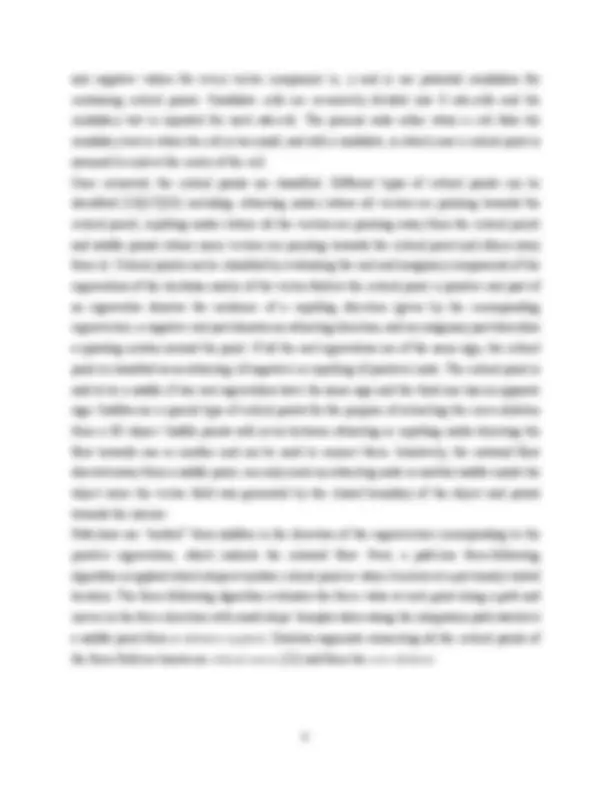
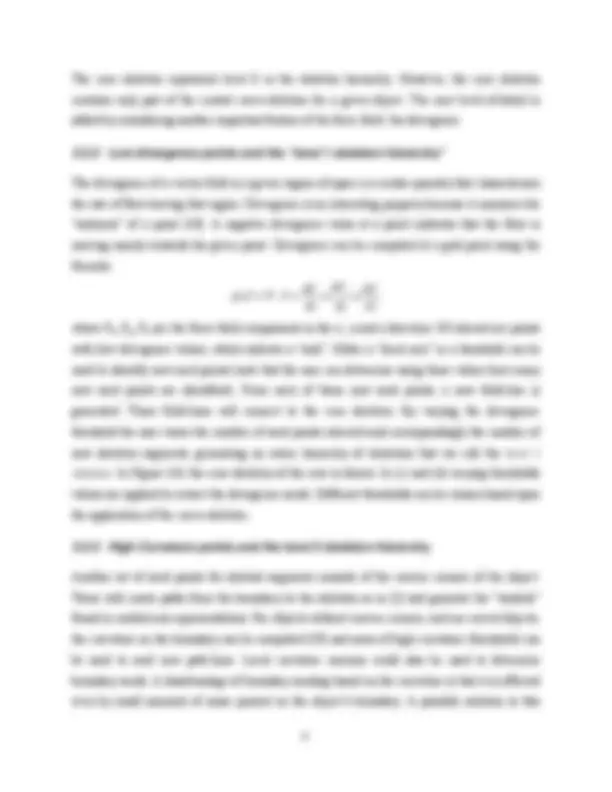
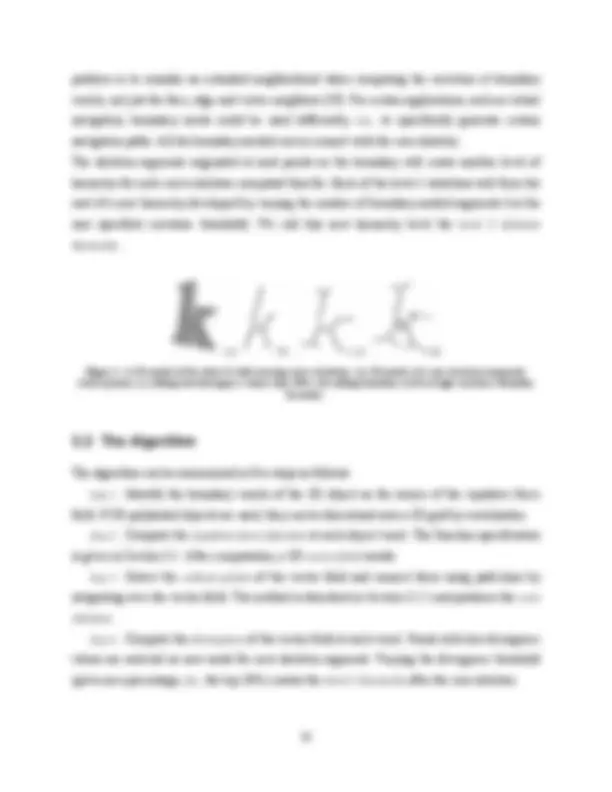
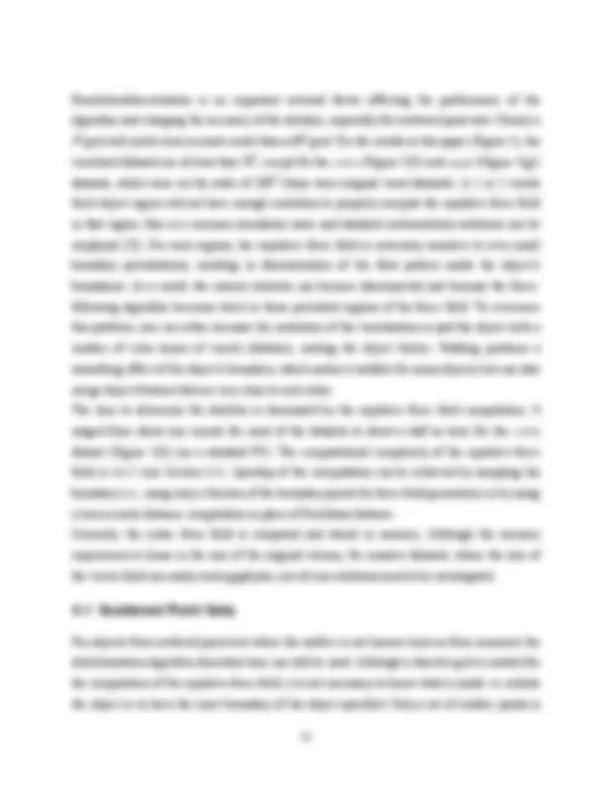
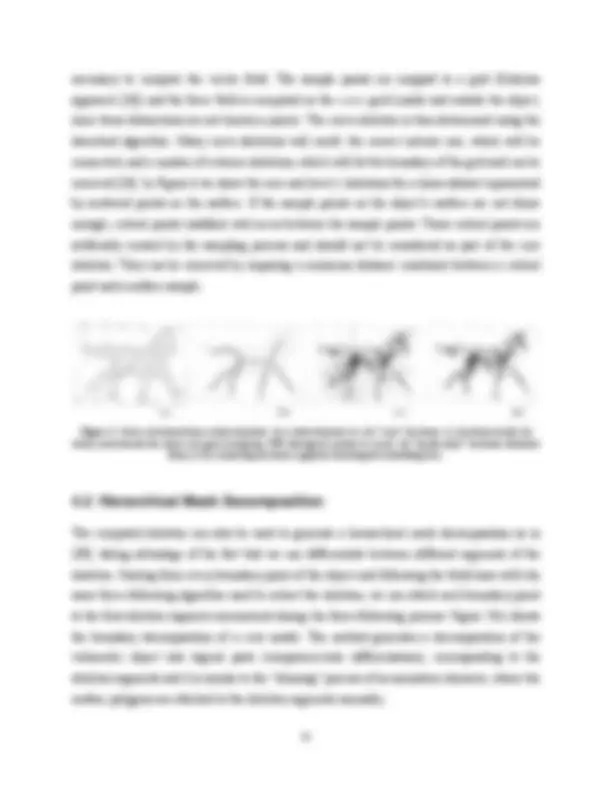
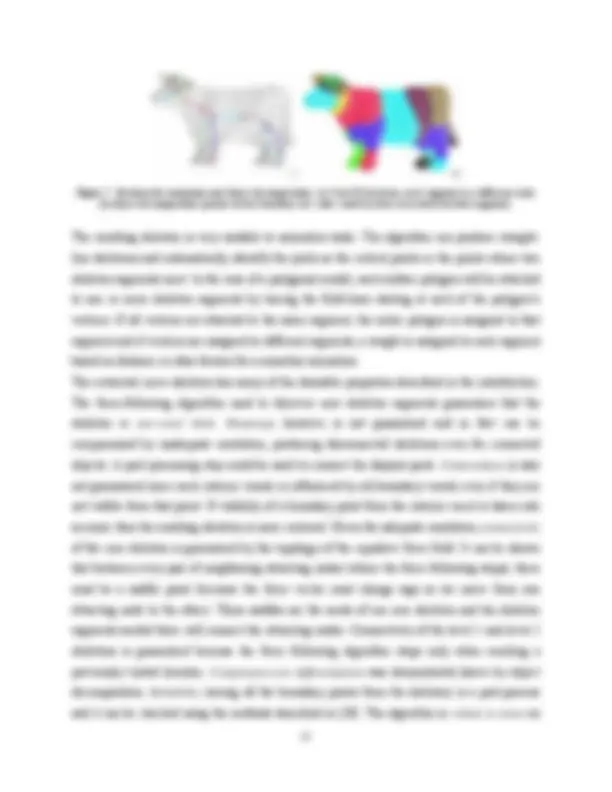
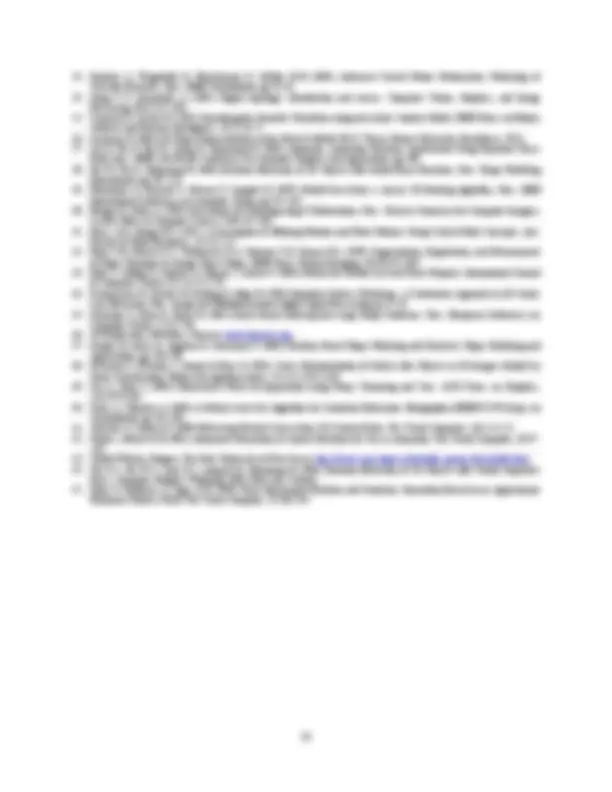


Study with the several resources on Docsity

Earn points by helping other students or get them with a premium plan


Prepare for your exams
Study with the several resources on Docsity

Earn points to download
Earn points by helping other students or get them with a premium plan
Community
Ask the community for help and clear up your study doubts
Discover the best universities in your country according to Docsity users
Free resources
Download our free guides on studying techniques, anxiety management strategies, and thesis advice from Docsity tutors
An algorithm for extracting curve-skeletons from 3D objects using a repulsive force field and vector field topology concepts. The method is applicable to various types of 3D representations, including polygonal surfaces, volumetric datasets, and scattered point sets. It automatically detects critical points, extracts a hierarchy of skeletons, and has advantages over previous methods. The document also covers the computational complexity and considerations for objects with tapered limbs.
Typology: Lecture notes
1 / 18

This page cannot be seen from the preview
Don't miss anything!











Department of Electrical and Computer Engineering, Rutgers, The State University of New Jersey, Piscataway, NJ 08855, USA E-mail: cornea, silver, xiaosong, balaiitm @ece.rutgers.edu
Abstract:
A curve-skeleton of a 3D object is a stick-like figure or centerline representation of that object. It is used for diverse applications, including virtual colonoscopy and animation. In this paper we introduce the concept of hierarchical curve-skeleton and describe a general and robust methodology which computes a family of increasingly detailed curve-skeletons. The algorithm is based upon computing a repulsive force field over a discretization of the 3D object and using topological characteristics of the resulting vector field, such as critical points and critical curves, to extract the curve-skeleton. We demonstrate this method on many different types of 3D objects (volumetric, polygonal and scattered point sets) and discuss various extensions of this approach.
Keywords: 3D curve-skeleton, repulsive force field
Figure 1: Curve-skeleton hierarchy for the (a) cow model: (b) core skeleton, (c) using 30% low divergence seeds, (d) using 55% low divergence seeds.
A skeleton is a useful shape abstraction that captures the essential topology of an object in both two and three dimensions. It refers to a thinned version of the original object, which still retains the shape properties of the original object. In 2D, the skeleton is also referred to as the medial- axis. In 3D, the term “skeleton” has been used to describe both a medial-surface and a more line- like representation. In the grass-fire analogy given in [9] the skeleton consists of the points where different fire fronts intersect. If a fire was simultaneously started on the perimeter of the grass
(the boundary of the object) the fire would proceed to burn towards the interior of the object. When two fire fronts meet each other the fire will be quenched. In 2D, the fire will quench along a curve. In 3D, the fire fronts will meet along a surface or a curve. Recently, there has been interest in extracting a line-like 1D skeletal-representation from a 3D object. The line-like skeleton is also referred to as a curve-skeleton [38], inverse-kinematic skeleton (IK-skeleton) [36], or centerline. In this paper, we refer to it as a curve-skeleton. Curve- skeletons are useful for many different geometric tasks, such as, virtual colonoscopy and virtual endoscopy [20][45], 3D object registration and visualization [5][6][32], computer animation (both polygonal and volume animation) [8][15][16][27][36][39][42], shape matching [11][35][37], surface reconstruction [26], vessel tracking [6], and curved planar reformation [22][23]. While there is no precise definition for a curve-skeleton, there are numerous desirable properties of both the skeleton and the skeleton computation process. These properties depend upon the application that the curve-skeleton is being used for, and include some of the following: the skeleton should be thin, ideally 1-voxel thick, it should capture the “essential shape” of the object ( homotopy ) [24], it should be centered within the object, it should be connected , different segments of the skeleton should be distinguishable ( component -wise differentiation), and every interior boundary point should be visible from the skeleton ( reliability [20]). This last property is desirable for virtual colonoscopy applications. Furthermore, the skeleton computation process should be robust and insensitive to small perturbations/noise on the boundary or to rotations of the object, efficient to compute, reversible, so that the original object can be reconstructed from the skeleton and hierarchical, i.e., allows different hierarchies or level-of-detail skeletons (multiscale [33]) to be computed where each hierarchical level is included in the next level. Many of these properties are conflicting, for example an object cannot be accurately reconstructed from a thin skeleton. The last property is an important one since a hierarchical skeleton would allow different curve-skeletons to be computed using the same process. An example of a hierarchical curve-skeleton is shown in Figure 1. In this paper, we introduce the concept of a hierarchical curve-skeleton and present a method to extract these curve-skeletons from a general 3D object. We also demonstrate how this technique is applicable to all types of 3D objects: polygonal surface representations, volumetric datasets and scattered point sets. Extensions to mesh decomposition and animation are also discussed. The algorithm was applied to many 3D objects, some of which are shown in this paper (the
the source point and the resulting skeleton is not always centered. In [39], a geometric method is presented which clusters the surface polygons (mesh decomposition) and then determines the IK skeleton from the polygon clusters. Levels-of-detail can be generated by adjusting the size of the polygonal surface clusters, however, the resulting skeletons will not be a strict hierarchy. In this paper, we show how the hierarchical curve-skeleton can be used to decompose the polygon mesh (the inverse of [39]). Another set of methods attempts to compute some continuous quench function over the object and detect the extremes of that function (which should lie close or on the centerline of the object). These methods include those that use a type of field [1][2][10][12][18][25][27], radial- basis function [28] and intensity maxima [5][6][32]. Most of the above papers do not discuss a hierarchical approach to the curve-skeletonization problem. However, these methods are similar to the approach taken here and are discussed in detail below. In [2] and [12], 2D and 3D skeletonization algorithms based upon a generalized potential field are presented. “Seed” points near the convex corners of the object are selected and the repulsive force (gradient of the potential field) is analytically derived only along a path determined using a force-following algorithm. Each path started at a seed point ends at a potential minimum detected by a major change in the repulsive force vector direction. The resulting skeleton segments are usually disconnected pieces and a separate re-connection step is necessary to assure connectivity. No hierarchy is defined and only polygonal objects can be handled. A similar approach is taken in [44]. The visible repulsive force defined there is a special case of the repulsive force used in [2] and [12]: the Newtonian repulsive force. Additionally, the force is computed using only a few samples on the boundary (the visible set) determined by the intersection with a number of sampling rays originating at the current position on the path. The resulting skeleton is not smooth and the identified joints are not robust. In [27], the same visible repulsive force is used, but the force field is computed over the entire voxelized object. The skeleton is extracted using a combination of thinning, clustering and graph searching algorithms and it is unclear how these affect the final position of the identified joints.
Without loss of generality, and to simplify the discussion in the remainder of the paper, we assume that a 3D object refers to a 3D voxelized discretization of that object. Polygonal models
can be converted into volumetric objects by voxelization [14]. In Section 4.1, we also show how the method is applicable to objects represented as scattered point sets. The methodology presented here is an enhancement and extension of the methods presented in [2][12][27][44]. We explicitly compute a repulsive force field over the entire object as in [27] (not just along the path as in [2][12][44]). The resulting 3D dataset is a vector field : a 3D array where each voxel contains a vector value (magnitude and direction). The difference from all the previously discussed approaches is that once we compute this vector field, we use its topological characteristics [13][17][21] such as critical points and low divergence points together with high curvature points on the boundary, to extract our skeleton hierarchy. The presented methodology has a number of significant advantages over the previous methods, namely: it directly produces connected skeletons without the use of a re-connection step, it works both on un-segmented objects (where only the boundary of the object is known) and segmented objects (where the interior is known), it has the ability to produce a strict hierarchy of skeletons and it has the ability to automatically extract an “IK skeleton” that can be used for animation i.e., the joints are automatically identified.
Our repulsive force is defined similarly to the repulsive force of the generalized potential field [2][12]. The key idea behind the potential field approach is to generate a force field inside the object by charging the object’s boundary. The basic procedure to compute the generalized potential and force for polyhedral objects is summarized in [12]. Since our algorithm operates on 3D objects represented by voxels, our boundary elements are also voxels, and we consider them to be point charges (this also simplifies the calculations involved in computing the force field). A boundary point is defined as an object voxel that has an exterior (empty) neighbor. An interior voxel (interior point) is an object voxel whose neighbors are all object voxels. The repulsive force at a point due to a nearby point charge is defined as a force pushing the point away from the charge with a strength that is inverse proportional to a power of the distance between the point and the charge namely:
PC (^) R m
visibility with a line-of-sight calculation, which checks to see that the surface is not pierced when connecting a point to a charge with a straight line. While this is more accurate, it unfortunately increases the running time substantially and is only applicable if the surface is known. Using a high order of m also minimizes this effect [2] by reducing the influence of more distant boundary charges. The computational complexity of the force field calculation depends on the number of object and boundary voxels: where No is the number of object voxels and Nb is the number of
boundary voxels. Since Nb is a fraction of No , the computational complexity is approximately O(No
O ( No × Nb )
(^2) ). This is the most time consuming step of the algorithm, accounting for about 98% of the
total running time.
Given a 3D vector field, certain concepts from vector field visualization can be used to identify three different types of “seed points” in the vector field. The seeds are the starting point of “field- lines” or “stream-lines” (these lines are found by “force-following”) which define our curve- skeleton segments.
3.2.1 Critical points and the “core skeleton”
Critical points are important vector field topology components and are often used in vector field visualization. These are the points where the magnitude of the force vector vanishes. In Figure 2, a critical point is visible in the middle of the head of the chess piece. In [13][17][21][31], a full discussion of the visualization of vector-field topology and the different types of critical points can be found. In what follows, we present a brief description relevant to extracting the curve- skeleton. Critical points are difficult to locate in a vector field, particularly because they do not necessarily occur at the given sample locations, but often occur in between sampling points. A good heuristic for detecting critical points is described in [17]: a zero in the vector field occurs when all 3 components of the force vector (x, y and z) vanish, thus, if we can identify a region where each vector component changes sign, the region is a candidate for containing a critical point. In our case, the smallest region we can consider is a voxel cell; the force field value is evaluated at each of the 8 corners of a grid cell using tri-linear interpolation. Cells containing both positive
and negative values for every vector component (x, y and z) are potential candidates for containing critical points. Candidate cells are recursively divided into 8 sub-cells and the candidacy test is repeated for each sub-cell. The process ends either when a cell fails the candidacy test or when the cell is too small, and still a candidate, in which case a critical point is assumed to exist at the center of the cell. Once extracted, the critical points are classified. Different types of critical points can be identified [13][17][31] including: attracting nodes (where all vectors are pointing towards the critical point), repelling nodes (where all the vectors are pointing away from the critical point) and saddle points (where some vectors are pointing towards the critical point and others away from it). Critical points can be classified by evaluating the real and imaginary components of the eigenvalues of the Jacobian matrix of the vector-field at the critical point: a positive real part of an eigenvalue denotes the existence of a repelling direction (given by the corresponding eigenvector), a negative real part denotes an attracting direction, and an imaginary part describes a spiraling motion around the point. If all the real eigenvalues are of the same sign, the critical point is classified as an attracting (if negative) or repelling (if positive) node. The critical point is said to be a saddle if two real eigenvalues have the same sign and the third one has an opposite sign. Saddles are a special type of critical points for the purpose of extracting the curve-skeleton from a 3D object. Saddle points will occur between attracting or repelling nodes directing the flow towards one or another and can be used to connect them. Intuitively, the outward flow directed away from a saddle point, can only reach an attracting node or another saddle inside the object since the vector field was generated by the closed boundary of the object and points towards the interior. Path-lines are “seeded” from saddles in the direction of the eigenvectors corresponding to the positive eigenvalues, which indicate the outward flow. Next, a path-line force-following algorithm is applied which stops at another critical point or when it arrives at a previously visited location. The force-following algorithm evaluates the force value at each point along a path and moves in the force direction with small steps. Samples taken along the integration path started at a saddle point form a skeleton segment. Skeleton segments connecting all the critical points of the force field are known as critical-curves [21] and form the core skeleton.
problem is to consider an extended neighborhood when computing the curvature at boundary voxels, not just the face, edge and vertex neighbors [19]. For certain applications, such as virtual navigation, boundary seeds could be used differently, i.e., to specifically generate certain navigation paths. All the boundary-seeded curves connect with the core skeleton. The skeleton segments originated at seed points on the boundary will create another level of hierarchy for each curve-skeleton computed thus far. Each of the level-1 skeletons will form the root of a new hierarchy developed by varying the number of boundary-seeded segments (via the user specified curvature threshold). We call this new hierarchy level the level 2 skeleton hierarchy.
Figure 3: A 3D model of the letter K with varying curve-skeletons. (a) 3D model, (b) core skeleton using only critical points, (c) adding low divergence values (top 20%), (d) adding boundary seeds at high curvature boundary locations.
The algorithm can be summarized in five steps as follows: Step 1. Identify the boundary voxels of the 3D object as the source of the repulsive force field. If 3D polyhedral objects are used, they can be discretized onto a 3D grid by voxelization. Step 2. Compute the repulsive force function at each object voxel. The function specification is given in Section 3.1. After computation, a 3D vector-field results. Step 3. Detect the critical points of the vector field and connect them using path-lines by integrating over the vector-field. The method is described in Section 3.2.1 and produces the core skeleton. Step 4. Compute the divergence of the vector-field at each voxel. Points with low divergence values are selected as new seeds for new skeleton segments. Varying the divergence threshold (given as a percentage, i.e., the top 20%) creates the level 1 hierarchy after the core skeleton.
Step 5. Compute the curvature at every boundary voxel and select new seed points based on a user-supplied curvature threshold, given again as a percentage of the highest curvature value in the dataset (i.e. top 30%). This adds another level of hierarchy to the core and divergence skeletons, the level 2 skeleton hierarchy. Note that the boundary seeds can be added either directly to the core skeleton or to a level 1 skeleton. However, a strict hierarchy is achieved only if the hierarchy levels below the current level are fixed: for example, in order to generate a strict level 2 hierarchy, the core skeleton and the number of divergence seeds must be fixed and only the number of boundary seeds is allowed to vary. The curve-skeleton extraction algorithm described here is general, and can also be used to extract a curve-skeleton from other types of quench functions such as [1][18][27][28].
The skeleton produced by the algorithm consists of a set of seed points connected by points sampled by the force-following algorithm. Alternatively, each curve sample can be mapped to the nearest grid location, creating a less smooth voxel skeleton, consistent with the discretized nature of the original 3D object. Figure 4(a) shows the curve representation and 4(c) shows the corresponding voxel skeleton of a cow model. Another approach, useful for animation [16][42] or matching [37], is to transform the skeleton into straight-line segments by treating the critical points and the points where different skeleton segments meet as “joints” and connecting these points with straight lines. The resulting skeleton will be suitable for importing into commercial animation packages (Maya, 3D Studio Max, etc) since the joints are automatically detected (joints are the end-points of skeleton segments). In the discussion section we show how the “skinning” process (attaching surface polygons to the skeleton) can also be done automatically using the repulsive force field. Figure 4(d) shows the IK-skeleton for the cow.
Figure 4: Skeleton representations for the cow model (a): curve skeleton (b), voxel skeleton (c) and straight-line skeleton (d).
Resolution/discretization is an important external factor affecting the performance of the algorithm and changing the accuracy of the solution, especially for scattered point sets. Clearly a 43 grid will yield a less accurate result than a 60^3 grid. For the results in this paper (Figure 5), the voxelized datasets are all less than 70^3 , except for the colon (Figure 5(f)) and angio (Figure 5(g)) datasets, which were on the order of 200^3 (these were original voxel datasets). A 1 or 2 voxels thick object region will not have enough resolution to properly compute the repulsive force field in that region (this is a common simulation issue and standard mutiresolution solutions can be employed [7]). For such regions, the repulsive force field is extremely sensitive to even small boundary perturbations, resulting in discontinuities of the flow pattern inside the object’s boundaries. As a result, the interior skeleton can become disconnected just because the force- following algorithm becomes stuck in these perturbed regions of the force field. To overcome this problem, one can either increase the resolution of the voxelization or pad the object with a number of extra layers of voxels (dilation), making the object thicker. Padding produces a smoothing effect of the object’s boundary, which makes it suitable for noisy objects, but can also merge object features that are very close to each other. The time to determine the skeleton is dominated by the repulsive force field computation. It ranged from about one minute for most of the datasets to about a half an hour for the colon dataset (Figure 5(f)) (on a standard PC). The computational complexity of the repulsive force field is O(n^2 ) (see Section 3.1). Speedup of the computation can be achieved by sampling the boundary (i.e., using only a fraction of the boundary points for force field generation) or by using a less accurate distance computation in place of Euclidean distance. Currently, the entire force field is computed and stored in memory. Although the memory requirement is linear in the size of the original volume, for massive datasets, where the size of the vector field can easily reach gigabytes, out-of-core solutions need to be investigated.
For objects from scattered point sets where the surface is not known (such as from scanners) the skeletonization algorithm described here can still be used. Although a discrete grid is needed for the computation of the repulsive force field, it is not necessary to know what is inside vs. outside the object or to have the exact boundary of the object specified. Only a set of surface points is
necessary to compute the vector field. The sample points are mapped to a grid (Eulerian approach [26]) and the force field is computed on the entire grid (inside and outside the object, since these distinctions are not known a-priori). The curve-skeleton is then determined using the described algorithm. Many curve-skeletons will result: the correct interior one, which will be connected, and a number of exterior skeletons, which will hit the boundary of the grid and can be removed [26]. In Figure 6 we show the core and level-1 skeletons for a horse dataset represented by scattered points on the surface. If the sample points on the object’s surface are not dense enough, critical points (saddles) will occur between the sample points. These critical points are artificially created by the sampling process and should not be considered as part of the core skeleton. They can be removed by imposing a minimum distance constraint between a critical point and a surface sample.
Figure 6: Curve-skeleton from scattered points: (a) scattered point set, (b) “core” skeleton. (c) skeleton inside (in black) and outside the object (in gray) using top 20% divergence points as seeds. (d) “inside-only” skeleton obtained from (c) by removing skeleton segments touching the bounding box.
The computed skeleton can also be used to generate a hierarchical mesh decomposition as in [39], taking advantage of the fact that we can differentiate between different segments of the skeleton. Starting from every boundary point of the object and following the field-lines with the same force-following algorithm used to extract the skeleton, we can attach each boundary point to the first skeleton segment encountered during the force-following process. Figure 7(b) shows the boundary decomposition of a cow model. The method generates a decomposition of the volumetric object into logical parts (component-wise differentiation), corresponding to the skeleton segments and it is similar to the “skinning” process of an animation character, where the surface polygons are attached to the skeleton segments manually.
the object’s boundary because a central core is detected. In Figure 8(d), the skeleton of a 3D object with noise is shown. The levels of hierarchy will be different for the object with noise and without but this can be controlled by varying the threshold used for the divergence values or by padding the object. Quantitative comparisons of the skeleton can be made by either comparing critical points and/or the entire path lines.
Figure 8: Object (a) and skeleton (b). Object with artificially added noise (c) and corresponding skeleton (d).
Although the algorithm presented here is not as fast as the distance field-based approaches, the resulting curve-skeleton is much cleaner. Reconstruction of the original object is generally not possible from curve-skeletons because they retain only the core of the original shape.
In this paper, we have presented a robust algorithm to extract the curve-skeleton from any 3D object, polygonal, voxel or scattered point set. It is based upon computing a repulsive force field and using vector-field topology to extract a family of hierarchical curve-skeletons. The curve- skeleton hierarchy that results from the method described can be tailored to many different applications including virtual navigation, animation, and matching.
We gratefully acknowledge the support of the National Science Foundation (ITR 0118760) and (ITR 0082634). We would like to thank J. Dwoskin for the implementation of the voxelization code. The algorithm was implemented in C++ and can be downloaded from [43]. The online program takes as input a small number of parameters: the order of the repulsive force function m , a divergence threshold and a growth factor. The growth factor is used to overcome resolution problems as described above.